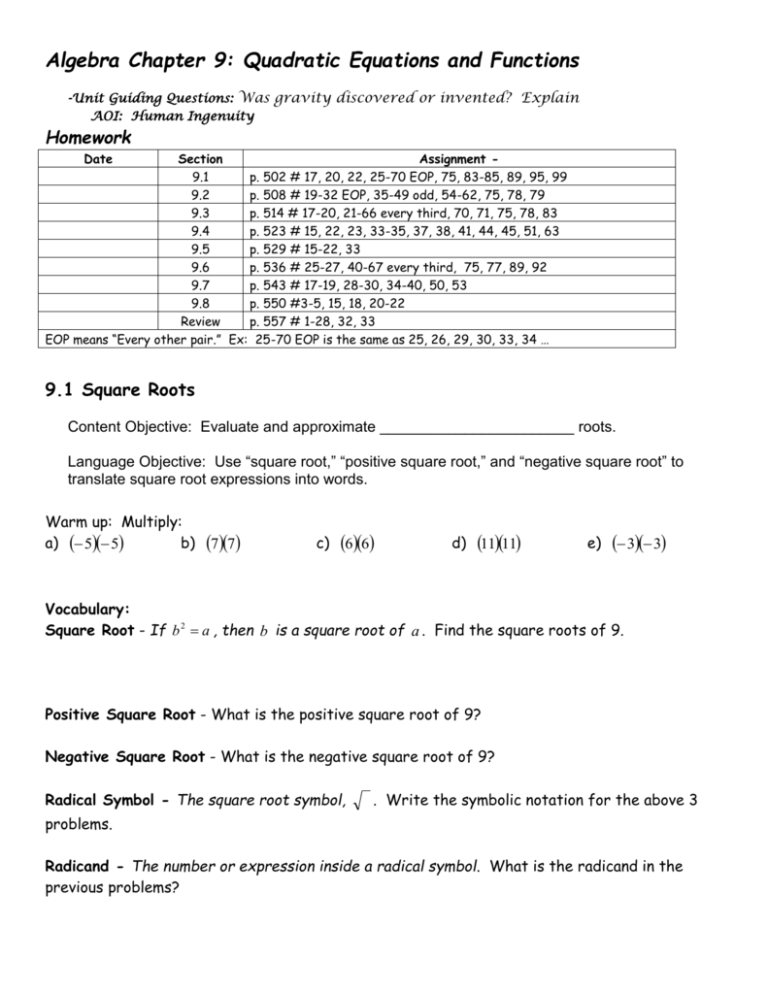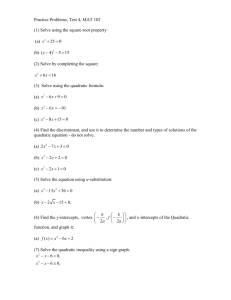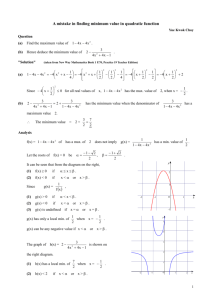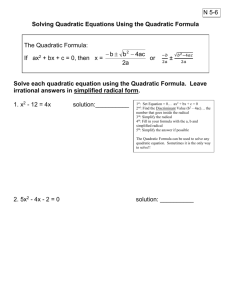Algebra 2.1 RULES OF ALGEBRA Name
advertisement

Algebra Chapter 9: Quadratic Equations and Functions -Unit Guiding Questions: Was gravity discovered or invented? Explain AOI: Human Ingenuity Homework Date Section Assignment 9.1 p. 502 # 17, 20, 22, 25-70 EOP, 75, 83-85, 89, 95, 99 9.2 p. 508 # 19-32 EOP, 35-49 odd, 54-62, 75, 78, 79 9.3 p. 514 # 17-20, 21-66 every third, 70, 71, 75, 78, 83 9.4 p. 523 # 15, 22, 23, 33-35, 37, 38, 41, 44, 45, 51, 63 9.5 p. 529 # 15-22, 33 9.6 p. 536 # 25-27, 40-67 every third, 75, 77, 89, 92 9.7 p. 543 # 17-19, 28-30, 34-40, 50, 53 9.8 p. 550 #3-5, 15, 18, 20-22 Review p. 557 # 1-28, 32, 33 EOP means “Every other pair.” Ex: 25-70 EOP is the same as 25, 26, 29, 30, 33, 34 … 9.1 Square Roots Content Objective: Evaluate and approximate _______________________ roots. Language Objective: Use “square root,” “positive square root,” and “negative square root” to translate square root expressions into words. Warm up: Multiply: a) 5 5 b) 77 c) 66 d) 1111 e) 3 3 Vocabulary: Square Root - If b 2 a , then b is a square root of a . Find the square roots of 9. Positive Square Root - What is the positive square root of 9? Negative Square Root - What is the negative square root of 9? Radical Symbol - The square root symbol, . Write the symbolic notation for the above 3 problems. Radicand - The number or expression inside a radical symbol. What is the radicand in the previous problems? 1) Write the equation in words. a. 16 4 b. 16 4 c. 16 4 Perfect Squares - The squares of __________________. List the first 25 perfect squares. 2) Evaluate the expression. a. 100 e. 225 b. 256 c. 196 d. f. g. 81 h. 0 400 361 3) Evaluate the expression. Give the exact value if possible. Otherwise, approximate to the nearest hundredth. a. 25 b. 23 c. 5 d. 36 e. 33 f. 8 g. h. 64 i. 133 576 4) Evaluate b 2 4ac for the given values. a. a 2, b 3, c 5 b. a 2, b 3, c 2 5) Use a calculator to evaluate the expression. Round the results to the nearest hundredth. a. 6 5 d. 4 8 b. 2 3 3 e. 5 2 4 c. 45 2 8 f. 23 6 4 6) Determine whether the statement is true or false. If it is true, give an example. If it is false, give a counterexample. a. All positive numbers have two different square roots. b. No number has only one square root. c. Some numbers have no real square root. 9.2 Solving Quadratic Equations by Finding Square Roots Content Objective: Solve ____________________________ equations by finding square roots. Warm up: Solve. a) 2x 5 11 b) 3 y 12 24 c) 14t 620 2t 0 d) 2x 8 x 10 Galileo Galilei, born in Pisa, Italy, in 1564, discovered that objects fall with the same acceleration, regardless of the mass. In a famous experiment, he hypothesized that if a cannonball and a stone were dropped from the Leaning Tower of Pisa, both would hit the ground at the same time. The equation h 16t 2 185 models the objects height after t seconds. In general, the falling object model is given by h 16t 2 s . h is the height of the object in feet, t is the number of seconds the object has fallen, and s is the initial height from which the object was dropped. Complete the table for h 16t 2 185 . Time, t 0 1 Height, h 2 3 4 a. What does 0 represent for t ? b. What does it mean when h 0 ? Estimate the time when h 0 . Later in the lesson, we will figure out a better estimate. Using Square roots The equation x 2 9 can be stated as the question, “What number multiplied by itself is 9.” There are two such numbers, -3 and 3. Each of these is called a square root of 9. The positive square root of a number is called the ______________ square root. It is indicated by the radical sign . In general, if x 2 d and d 0 , then x d or x d . You can write this as d , which is read plus or minus the square root of d. 1) Solve each equation. a. x 2 25 b. y 2 11 c. a 2 9 4 d. m 2 10 49 e. n 2 0 f. x 2 9 You Try! g. z 2 100 h. x 2 25 4 i. p 2 4 j. x 2 7 A ____________________ equation is an equation that can be written in the standard form ax 2 bx c 0 where a 0 . a is called the _________________ coefficient. When b 0 , this equation becomes ax 2 c 0 . These equations can be solved by finding square roots, but first, we must isolate the x 2 on one side of the equation!!! So, get the equation into the form x 2 d . If d 0 , then x 2 d has ______ solutions: x d . If d 0 , then x 2 d has ______ solution: x 0 . If d 0 , then x 2 d has ______ real solution. 2) Solve each equation. a. x 2 16 0 b. 2 x 2 72 0 c. 27 3 y 2 0 d. m 2 15 34 You Try! e. x 2 100 0 g. 32 2 y 2 0 h. m 2 4 68 f. 6n 2 150 0 3) Solve the equation 0 25t 2 144 using a calculator. 4) a. Now, find the exact time it takes an object to fall from the top of the Leaning Tower of Pisa. Use the formula h 16t 2 185 . You try!! b. i. Construction debris falls down 25 feet into a bin. Write a model for the height of the debris. Assume there is no air resistance. ii. How long will it take the debris to reach the bin? Round your solution to the nearest hundredth. 9.3 Simplifying Radicals Content Objective: Simplify ____________________________ expressions. List the prime factors of the following numbers. a) 28 b) 75 c) 32 List the first 12 perfect squares. For this lesson, we will use two properties: Product Property of Radicals: ab a b where a 0 and b 0 . Quotient Property of Radicals: a a where a 0 and b 0 . b b 1) Simplify the expression using the product property. a. 12 b. 2 75 c. 180 You try!! d. f. 63 32 e. 3 98 2) Simplify the expression using the quotient property. a. 4 9 b. 80 45 c. 5 1 25 d. 11 4 e. 8 9 25 36 g. 8 50 h. 7 4 9 i. 5 9 j. 20 49 You try!! f. An expression is not considered simplified if a radical appears in the denominator. Eliminating a radical from the denominator is called "rationalizing the denominator." 3) Simplify the expression. a. 1 3 b. 27 15 c. 5 2 d. 13 18 e. 4 7 You try!! f. 4 7 g. 36 20 h. 11 3 i. 5 12 j. 25 2 4) The distance d (in miles) that you can see to the horizon can be modeled by the quadratic equation d 2 1.5h , where h is your height in feet. Use this model to find the distance you can see from the top of a 400 ft building in terms of radicals. Then find the distance to the nearest tenth. 5) Summarize the 3 things that need to be true for a radical expression to be in simplest form and show an example of each. A radical expression is in simplest form if there are … 1. no _____________________ square factors other than 1 in the radicand, 18 2. no ____________________ are in the radicand, and 7 25 3. no radicals are in the ______________________ of a fraction. 3 2 9.4 Graphing Quadratic Functions Content Objective: Sketch the graph of a ____________________________ function. Warm up: Evaluate the expression 3 x 2 4 x 1 for x 2 . A ____________________ function is a function that can be written in the standard form y ax 2 bx c where a 0 . Quadratic functions have a U-shaped graph called a _______________________. A parabola opens up if a is __________________. A parabola opens down if a is __________________. The highest or lowest point of the graph is called the ________________. c is the ____________________ of the parabola. 1) Decide whether the parabola opens up or down. a. y 5 x 2 2 x 7 b. y x 2 3x c. y 2 x 3x 2 Here are the steps for graphing a quadratic function: b . 2a 2. Make a table of values, using x-values to the left and right of the vertex. 3. Plot the points and connect them with a smooth curve to form a parabola. 1. Find the x-coordinate of the vertex, which is x 2) The function y x 2 is the simplest quadratic function and is called the parent function of the class of quadratics. Use the table to graph it below. x y 2) Graph y x 2 1 . 3) Graph y x 2 3 . x y x y x y s 4) Graph y 2 x 2 5 x 1 . 5) Graph y 4 x 2 4 x 8 . x y 6) A bottle-nosed dolphin jumps out of the water. The path the dolphin travels can be modeled by h 0.2d 2 2d , where h represents the height of the dolphin and d represents the horizontal distance, both in feet. a. What is the vertex of the parabola? Interpret the result. b. What horizontal distance did the dolphin travel? 9.5 Solving Quadratic Equations by Graphing Content Objective: Use a ________________ to find or check a solution of a quadratic equation. Warm up: Evaluate y x 2 2 x 3 for x 3 and x 1. The x-intercepts of the graph of y ax 2 bx c are the solutions of the related equation ax 2 bx c 0 because x-intercepts are the x-coordinates of the points where y 0 . These solutions are sometimes called roots (not the same as square roots.) Use the warm up problem to find the solutions of the equation x 2 2 x 3 0 . Sketch a graph to show why these are the solutions. 1) The graph of y 2 x 2 4 x is shown. 2) The graph of y 13 x 2 3 is shown. Use the graph to estimate the solutions of 2 x 2 4 x 0 . 5 Use the graph to estimate the roots of 13 x 2 3 0 . 5 y 4 4 3 3 2 2 1 y 1 x -6 -5 -4 -3 -2 -1 1 2 3 4 5 6 7 8 x -7 -6 -5 -4 -3 -2 -1 1 -1 -1 -2 -2 -3 -3 -4 -5 -4 -5 2 3 4 5 6 7 For much of the work we do with quadratics, it’s important to put the equation into standard form: ax 2 bx c 0 3) Write the quadratic equation in standard form. a. 3x 2 x 12 b. 2 x 4 5 x 2 d. 4 x 2 25 e. 8 x 2 3x 4) Use a graph to estimate the solutions of x 2 x 6 . Check your answers. s x y c. 3x 2 10 d. 5 7 x 2 18 x 5) Use a graph to estimate the solutions of x 2 x 12 . Check your answers. x y 9.6 Solving Quadratic Equations by the Quadratic Formula Content Objective: Use the quadratic __________________________ to solve a quadratic _________________________. Warm Up: Use the quadratic form ax 2 bx c 0 to find the values of a, b, and c. 1. 3 x 2 2 x 4 a=___3____, b=____2___, c=___4_____ Add 3x 2 to both sides of the equation to get 3x 2 2 x 4 0 . 2. 4 x 1 2 x 2 3. 3 x 4. 1 2 x 2 2 2 9 x 7 x 2 a=_______, b=_______, c=________ a=_______, b=_______, c=________ a=_______, b=_______, c=________ The following formula below is used to solve any quadratic after finding the values of a, b, and c. Just plug them in and simplify. The Quadratic Formula For ax 2 bx c 0 , where a 0: x b b 2 4ac . 2a 1) Use the quadratic formula to solve or find the zeros (x-intercepts of the graph). a. x 2 3 x 10 b. x 2 12 4 x 0 c. y 3x 2 2 x 4 Vertical Motion Models Object is dropped: h 16t 2 s h height (feet) s initial height (feet) d. y 3x 2 x 5 Object is thrown: h 16t 2 vt s t time in motion (seconds) v initial velocity (feet per second) 2) You jump off a 15-foot high diving board with an initial upward velocity of 3 ft/sec. How long will it take you to hit the water? 3) Balloonists compete in a field target event at a hot-air balloon festival. Calculate the amount of time it takes for a marker to reach a target when thrown down from 150 ft with an initial downward velocity of -24 ft/sec. Round to the nearest hundredth of a second. 9.7 Using the Discriminant Content Objective: Use the __________________________ to determine the number of solutions of a quadratic equation. The Discriminant of a quadratic equation allows us to find how many real-number solutions the quadratic equation has. The Discriminant Given the quadratic equation ax 2 bx c 0 , where a 0, the discriminant is defined as b 2 4ac . 1. If the discriminant is ___________________, there are _________ real solutions. 2. If the discriminant is ____________________, there is exactly _______ solution. 3. If the discriminant is ____________________, there are ________ real solutions 1) Find the number of real solutions to each quadratic equation. a. 3x 2 2 x 1 0 b. 4 x 2 1 4 x d. 3x 2 5 x 1 0 e. x 2 2 x 4 2) Find the number of x-intercepts of the graph of the function. a. y x 2 6 x 10 b. y x 2 6 x 9 What effect does changing the value of c have on the graph? c. 6 x 2 23x 20 0 f. x 2 10 x 25 0 c. y x 2 6 x 7









